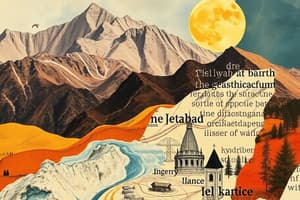Podcast
Questions and Answers
Which process involves the movement of Earth's lithospheric plates?
Which process involves the movement of Earth's lithospheric plates?
- Weathering
- Glacial Processes
- Hydrological Cycle
- Plate Tectonics (correct)
What type of soil is characterized by high organic matter content?
What type of soil is characterized by high organic matter content?
- Sandy
- Peaty (correct)
- Loamy
- Clay
What term describes the breakdown of rocks and the transportation of sediments?
What term describes the breakdown of rocks and the transportation of sediments?
- Deposition
- Weathering
- Erosion (correct)
- Glaciation
Which of the following biomes is known for its extreme cold and treeless landscape?
Which of the following biomes is known for its extreme cold and treeless landscape?
Which climate zone is characterized by hot, dry conditions?
Which climate zone is characterized by hot, dry conditions?
How are rivers, lakes, and oceans categorized in physical geography?
How are rivers, lakes, and oceans categorized in physical geography?
Which tool is used for mapping and analyzing geographic information?
Which tool is used for mapping and analyzing geographic information?
Which natural hazard is a result of tectonic activity?
Which natural hazard is a result of tectonic activity?
What is the primary method for understanding environmental changes?
What is the primary method for understanding environmental changes?
What major process leads to the formation of landforms by glaciers?
What major process leads to the formation of landforms by glaciers?
Flashcards are hidden until you start studying
Study Notes
Physical Geography
-
Definition: The branch of geography that deals with the natural environment and physical processes of the Earth.
-
Major Components:
-
Landforms:
- Types: mountains, hills, plateaus, plains, valleys.
- Processes: erosion, weathering, tectonic activity.
-
Climate and Weather:
- Climate Zones: tropical, arid, temperate, polar.
- Weather Patterns: precipitation, temperature, wind systems.
-
Soils:
- Types: sandy, clay, loamy, peaty.
- Formation processes: weathering of rocks, organic matter decomposition.
-
Biomes:
- Classification: tundra, rainforest, desert, grassland.
- Characteristics: flora, fauna, climate conditions.
-
Hydrology:
- Water Bodies: rivers, lakes, oceans, groundwater.
- Water Cycle: evaporation, condensation, precipitation, infiltration.
-
Natural Hazards:
- Types: earthquakes, volcanoes, tsunamis, floods, hurricanes.
- Impact on the environment and human activities.
-
-
Key Processes:
- Plate Tectonics: Movement of Earth's lithospheric plates causing geological activity.
- Weathering and Erosion: Breakdown of rocks and transportation of sediments.
- Glacial and Periglacial Processes: Formation of landforms due to glacial activity.
-
Human Interaction:
- Impact of human activities on physical geography (e.g., urbanization, deforestation, pollution).
- Importance of sustainable practices in preserving physical environments.
-
Tools and Techniques:
- Geographic Information Systems (GIS) for mapping and analysis.
- Remote Sensing: use of satellite imagery to study physical features.
-
Importance:
- Understanding natural processes and environmental changes.
- Informing conservation efforts and land use planning.
Definition
- Physical geography focuses on the natural environment and Earth's physical processes.
Major Components
-
Landforms:
- Includes mountains, hills, plateaus, plains, and valleys.
- Formed through erosion, weathering, and tectonic activity.
-
Climate and Weather:
- Climate zones are categorized as tropical, arid, temperate, and polar.
- Weather patterns encompass precipitation, temperature fluctuations, and wind systems.
-
Soils:
- Types include sandy, clay, loamy, and peaty soils.
- Formed by the weathering of rocks and decomposition of organic matter.
-
Biomes:
- Classified into tundra, rainforest, desert, and grassland.
- Each biome has distinct flora, fauna, and climate conditions.
-
Hydrology:
- Covers various water bodies such as rivers, lakes, oceans, and groundwater.
- Water cycle includes processes like evaporation, condensation, precipitation, and infiltration.
-
Natural Hazards:
- Types include earthquakes, volcanoes, tsunamis, floods, and hurricanes.
- They significantly impact both the environment and human activities.
Key Processes
-
Plate Tectonics:
- Involves the movement of Earth's lithospheric plates, triggering geological activity.
-
Weathering and Erosion:
- Breakdown of rocks leads to sediment transportation.
-
Glacial and Periglacial Processes:
- Create landforms through glacial activity.
Human Interaction
- Human activities, like urbanization and deforestation, affect physical geography.
- Sustainable practices are essential to maintain physical environments.
Tools and Techniques
-
Geographic Information Systems (GIS):
- Used for mapping and analyzing geographical data.
-
Remote Sensing:
- Employs satellite imagery to study Earth's physical features.
Importance
- Understanding natural processes is crucial for environmental change comprehension.
- Informs conservation efforts and effective land use planning.
Studying That Suits You
Use AI to generate personalized quizzes and flashcards to suit your learning preferences.





